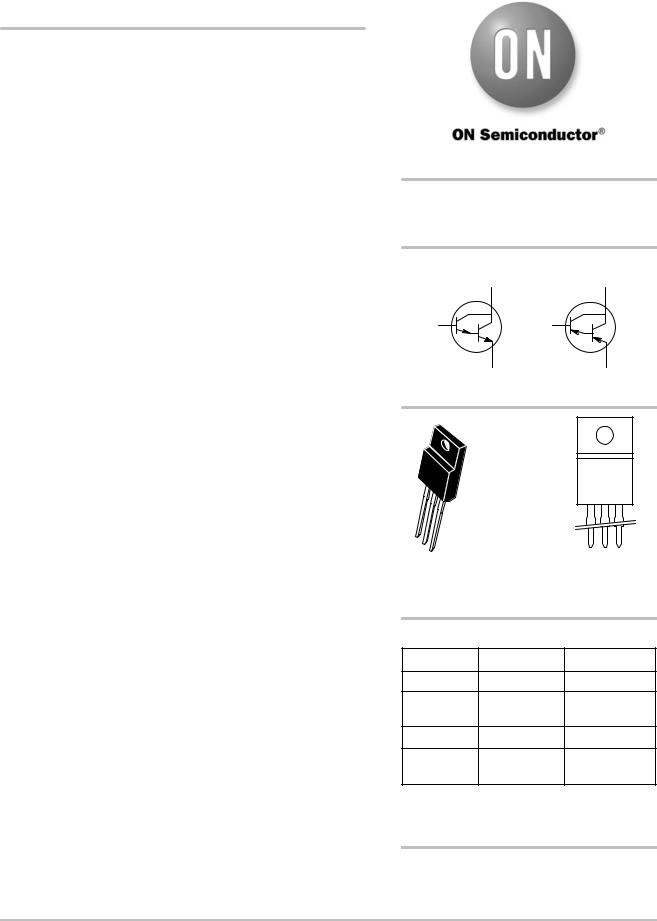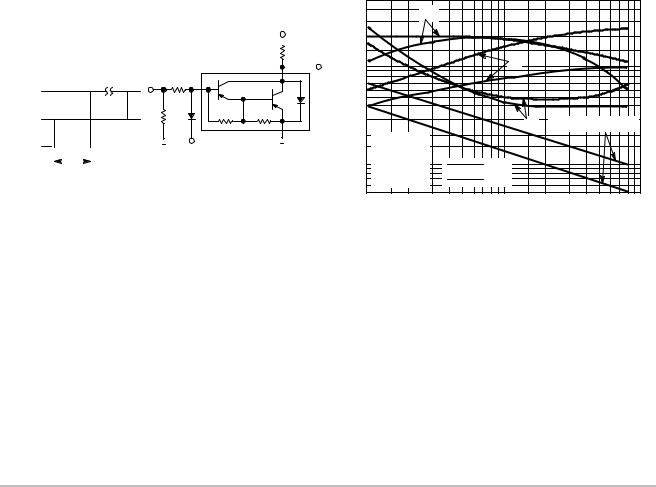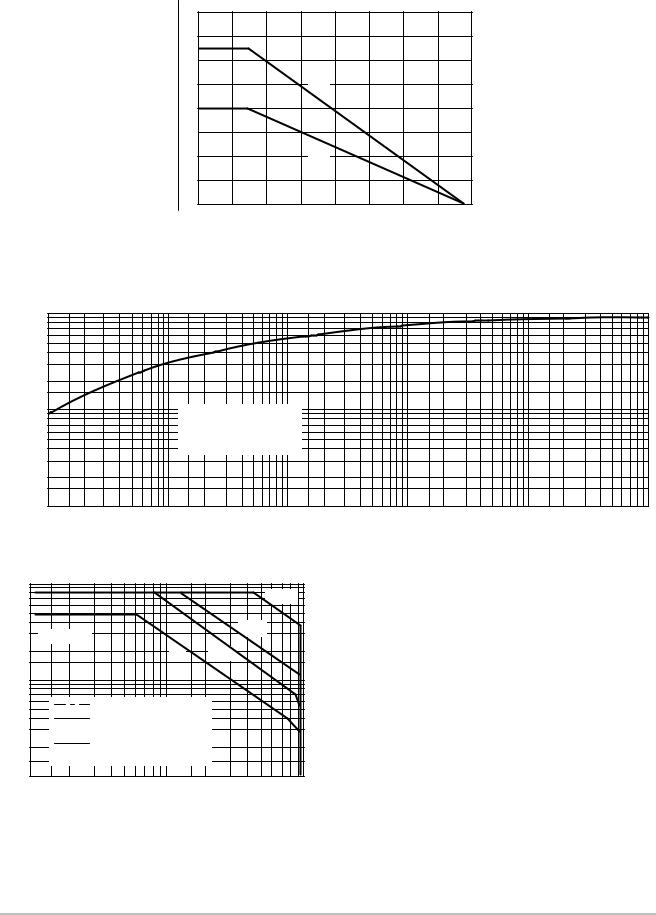ON Semiconductor MJF122, MJF127 Service Manual

MJF122, MJF127
Complementary Power
Darlingtons
For Isolated Package Applications
Designed for general−purpose amplifiers and switching applications, where the mounting surface of the device is required to be electrically isolated from the heatsink or chassis.
Features
•Electrically Similar to the Popular TIP122 and TIP127
•100 VCEO(sus)
•5.0 A Rated Collector Current
•No Isolating Washers Required
•Reduced System Cost
•High DC Current Gain − 2000 (Min) @ IC = 3 Adc
•UL Recognized, File #E69369, to 3500 VRMS Isolation
•Pb−Free Packages are Available*
MAXIMUM RATINGS
Rating |
Symbol |
Value |
Unit |
|
|
|
|
Collector−Emitter Voltage |
VCEO |
100 |
Vdc |
Collector−Base Voltage |
VCB |
100 |
Vdc |
Emitter−Base Voltage |
VEB |
5 |
Vdc |
RMS Isolation Voltage (Note 1) |
VISOL |
4500 |
VRMS |
(t = 0.3 sec, R.H. ≤ 30%, TA = 25°C) |
|
|
|
Per Figure 14 |
|
|
|
|
|
|
|
Collector Current − Continuous |
IC |
5 |
Adc |
Peak |
|
8 |
|
|
|
|
|
Base Current |
IB |
0.12 |
Adc |
Total Power Dissipation (Note 2) |
PD |
|
|
@ TC = 25_C |
|
30 |
W |
Derate above 25_C |
|
0.24 |
_ |
|
|
W/ C |
|
Total Power Dissipation @ TA = 25_C |
PD |
2 |
W |
Derate above 25_C |
|
0.016 |
_ |
|
|
W/ C |
|
Operating and Storage Junction Temperat- |
TJ, Tstg |
−65 to |
IC |
ure Range |
|
+150 |
|
|
|
|
|
THERMAL CHARACTERISTICS
Characteristic |
Symbol |
Max |
Unit |
Thermal Resistance, Junction−to−Ambient |
RqJA |
62.5 |
_C/W |
Thermal Resistance, Junction−to−Case |
RqJC |
4.1 |
_C/W |
(Note 2) |
|
|
|
Lead Temperature for Soldering Purpose |
TL |
260 |
_C |
Maximum ratings are those values beyond which device damage can occur. Maximum ratings applied to the device are individual stress limit values (not normal operating conditions) and are not valid simultaneously. If these limits are exceeded, device functional operation is not implied, damage may occur and reliability may be affected.
1.Proper strike and creepage distance must be provided.
2.Measurement made with thermocouple contacting the bottom insulated mounting surface (in a location beneath the die), the device mounted on a heatsink with thermal grease and a mounting torque of ≥ 6 in. lbs.
http://onsemi.com
COMPLEMENTARY SILICON POWER DARLINGTONS 5.0 A, 100 V, 30 W
|
|
NPN |
|
PNP |
|
|
COLLECTOR 2 |
COLLECTOR 2 |
|
|
BASE |
|
BASE |
|
|
1 |
|
1 |
|
|
|
EMITTER 3 |
EMITTER 3 |
|
|
|
MJF122 |
|
MJF127 |
|
|
MARKING |
|
|
|
|
DIAGRAM |
|
|
|
|
|
|
MJF12xG |
|
|
TO−220 |
AYWW |
|
|
|
|
||
|
|
CASE 221D−02 |
|
|
|
|
STYLE 2 |
|
|
1 |
2 3 |
x |
= 2 or 7 |
|
|
G |
= Pb−Free Package |
||
|
|
A |
= Assembly Location |
|
|
|
Y |
= Year |
|
|
|
WW |
= Work Week |
|
|
ORDERING INFORMATION |
|||
|
Device |
Package |
Shipping† |
|
MJF122 |
|
TO−220 |
50 Units / Rail |
|
MJF122G |
|
TO−220 |
50 Units / Rail |
|
|
|
(Pb−Free) |
|
|
MJF127 |
|
TO−220 |
50 Units / Rail |
|
MJF127G |
|
TO−220 |
50 Units / Rail |
|
|
|
(Pb−Free) |
|
|
†For information on tape and reel specifications, including part orientation and tape sizes, please refer to our Tape and Reel Packaging Specifications
Brochure, BRD8011/D.
*For additional information on our Pb−Free strategy and soldering details, please download the
ON Semiconductor Soldering and Mounting
Techniques Reference Manual, SOLDERRM/D.
♥ Semiconductor Components Industries, LLC, 2008 |
1 |
Publication Order Number: |
September, 2008 − Rev. 7 |
|
MJF122/D |

MJF122, MJF127
ELECTRICAL CHARACTERISTICS (TC = 25_C unless otherwise noted)
Characteristic |
|
Symbol |
Min |
Max |
Unit |
|
|
|
|
|
|
|
|
OFF CHARACTERISTICS |
|
|
|
|
|
|
|
|
|
|
|
|
|
Collector−Emitter Sustaining Voltage (Note 3) |
|
VCEO(sus) |
100 |
− |
Vdc |
|
(IC = 100 mAdc, IB = 0) |
|
|
|
|
|
|
Collector Cutoff Current |
|
ICEO |
− |
10 |
mAdc |
|
(VCE = 50 Vdc, IB = 0) |
|
|
|
|
|
|
Collector Cutoff Current |
|
ICBO |
− |
10 |
mAdc |
|
(VCB = 100 Vdc, IE = 0) |
|
|
|
|
|
|
Emitter Cutoff Current (VBE = 5 Vdc, IC = 0) |
|
IEBO |
− |
2 |
mAdc |
|
ON CHARACTERISTICS (Note 3) |
|
|
|
|
|
|
|
|
|
|
|
|
|
DC Current Gain (IC = 0.5 Adc, VCE = 3 Vdc) |
|
hFE |
1000 |
− |
− |
|
DC Current Gain (IC = 3 Adc, VCE = 3 Vdc) |
|
|
2000 |
− |
|
|
Collector−Emitter Saturation Voltage (IC = 3 Adc, IB = 12 mAdc) |
|
VCE(sat) |
− |
2 |
Vdc |
|
Collector−Emitter Saturation Voltage (IC = 5 Adc, IB = 20 mAdc) |
|
|
− |
3.5 |
|
|
Base−Emitter On Voltage (IC = 3 Adc, VCE = 3 Vdc) |
|
VBE(on) |
− |
2.5 |
Vdc |
|
DYNAMIC CHARACTERISTICS |
|
|
|
|
|
|
|
|
|
|
|
|
|
Small−Signal Current Gain (IC = 3 Adc, VCE = 4 Vdc, f = 1 MHz) |
|
hfe |
4 |
− |
− |
|
Output Capacitance |
MJF127 |
Cob |
− |
300 |
pF |
|
(VCB = 10 Vdc, IE = 0, f = 0.1 MHz) |
MJF122 |
|
− |
200 |
|
|
3. Pulse Test: Pulse Width v 300 ms, Duty Cycle v 2%.
RB & RC VARIED TO OBTAIN DESIRED CURRENT LEVELS |
|
|
VCC |
|
D1, MUST BE FAST RECOVERY TYPES, e.g., |
|
|
||
|
|
- 30 V |
||
Ç1N5825 USED ABOVE IB ≈ 100 mA |
RC |
|
||
|
|
|
||
ÇMSD6100 USED BELOW IB ≈ 100 mA |
|
SCOPE |
||
TUT |
|
|||
|
|
|
|
|
|
|
|
|
|
V2 |
|
RB |
|
|
APPROX. |
|
|
|
|
+8 V |
|
|
|
|
0 |
51 |
D1 |
Ń8 k |
Ń120 |
V1 |
|
|
|
|
|
|
|
|
|
||||
APPROX. |
|
|
|
|
|
|
|
|
+ 4 V |
||||
|
|
|
|
|
|
|
|||||||
-12 V |
|
|
|
|
|
|
|
||||||
|
|
25 ms |
|||||||||||
|
|
|
|
|
|||||||||
tr, tf ≤ 10 ns |
FOR td AND tr, D1 IS DISCONNECTED |
||||||||||||
DUTY CYCLE = 1% |
AND V2 = 0 |
||||||||||||
|
|
|
|
|
FOR NPN TEST CIRCUIT REVERSE ALL POLARITIES. |
||||||||
|
5 |
|
|
|
|
|
|
|
|
|
|
|
3 |
|
ts |
|
|
|
|
|
|
|
|
|
2 |
|
|
|
|
|
|
|
|
|
|
(ÇÉs)μ |
1 |
|
|
|
|
tf |
|
|
|
|
|
0.7 |
|
|
|
|
|
|
|
|
|
|
|
t, TIME |
0.5 |
|
|
|
|
|
|
|
|
|
|
0.3 |
|
|
|
|
t |
|
td @ VBE(off) = 0 V |
|
|||
|
|
|
|
|
r |
|
|||||
|
0.2 |
|
|
|
|
|
|
|
|
|
|
|
VCC = 30 V |
|
|
|
|
|
|
|
|
|
|
|
|
|
|
|
|
|
|
|
|
|
|
|
0.1 |
IC/IB = 250 |
|
|
PNP |
|
|
|
|
|
|
|
IB1 = IB2 |
|
|
|
|
|
|
|
|||
|
0.07 |
° |
|
|
NPN |
|
|
|
|
|
|
|
0.05 |
TJ = 25 C |
|
|
|
|
|
|
|
|
|
|
0.1 |
0.2 |
0.3 |
0.5 |
0.7 |
1 |
2 |
3 |
5 |
7 |
10 |
IC, COLLECTOR CURRENT (AMP)
Figure 1. Switching Times Test Circuit |
Figure 2. Typical Switching Times |
http://onsemi.com
2

|
|
|
|
MJF122, MJF127 |
|
|
||||
|
TA |
TC |
|
|
|
|
|
|
|
|
|
4 |
80 |
|
|
|
|
|
|
|
|
(WATTS) |
3 |
60 |
|
|
|
|
|
|
|
|
|
|
|
|
|
|
|
|
|
|
|
DISSIPATION |
|
|
|
|
|
TC |
|
|
|
|
2 |
40 |
|
|
|
|
|
|
|
|
|
|
|
|
|
|
|
|
|
|
|
|
, POWER |
1 |
20 |
|
|
|
TA |
|
|
|
|
|
|
|
|
|
|
|
|
|
|
|
D |
|
|
|
|
|
|
|
|
|
|
P |
|
|
|
|
|
|
|
|
|
|
|
|
0 |
|
40 |
60 |
80 |
100 |
120 |
140 |
160 |
|
|
0 |
20 |
|||||||
T, TEMPERATURE (°C)
Figure 3. Maximum Power Derating
|
|
1 |
|
|
|
|
|
|
|
|
|
|
|
|
|
|
|
|
|
|
|
|
|
RESISTANCE (NORMALIZED) |
0.5 |
|
|
|
|
|
|
|
|
|
|
|
|
|
|
|
|
|
|
|
|
r(t), TRANSIENT THERMAL |
0.3 |
|
|
|
|
|
|
|
|
|
|
|
|
|
|
|
|
|
|
|
|
|
0.2 |
|
|
|
|
|
|
|
|
|
|
|
|
|
|
|
|
|
|
|
|
||
0.1 |
|
|
|
|
SINGLE PULSE |
|
|
|
|
|
|
|
|
|
|
|
|
|
||||
|
|
|
|
|
|
|
|
|
|
|
|
|
|
|
|
|
|
|||||
0.05 |
|
|
|
|
RqJC(t) = r(t) RqJC |
|
|
|
|
|
|
|
|
|
|
|
|
|
||||
|
|
|
|
TJ(pk) - TC |
= P(pk) |
RqJC(t) |
|
|
|
|
|
|
|
|
|
|
|
|
||||
|
|
|
|
|
|
|
|
|
|
|
|
|
|
|
|
|
||||||
0.03 |
|
|
|
|
|
|
|
|
|
|
|
|
|
|
|
|
|
|
|
|
||
|
|
0.02 |
|
|
|
|
|
|
|
|
|
|
|
|
|
|
|
|
|
|
|
|
|
|
0.01 |
|
|
|
1 |
2 |
|
5 |
|
|
|
|
|
|
|
|
|
|
|
|
10K |
|
|
0.1 |
0.2 |
0.3 |
0.5 |
3 |
10 |
20 |
30 |
50 |
100 |
200 |
300 |
500 |
1K |
2K |
3K |
5K |
||||
t, TIME (ms)
Figure 4. Thermal Response
|
10 |
|
|
|
|
|
|
|
|
(AMPS) |
|
|
|
|
|
|
|
|
100 ms |
5 |
|
|
|
|
|
|
|
|
|
3 |
TJ = 150°C |
|
|
|
|
|
1Éms |
|
|
CURRENT |
|
|
|
|
|
|
|
||
2 |
|
|
|
|
d |
5 ms |
|
|
|
|
|
|
|
|
c |
|
|
|
|
1 |
|
|
|
|
|
|
|
|
|
COLLECTOR |
|
|
|
|
|
|
|
|
|
0.5 |
|
CURRENT LIMIT |
|
|
|
|
|||
|
SECONDARY BREAKDOWN |
|
|
|
|||||
0.3 |
|
|
|
|
|||||
|
LIMIT |
|
|
|
|
|
|
||
, |
|
|
|
|
|
|
|
|
|
C |
0.2 |
|
THERMAL LIMIT @ |
|
|
|
|
||
I |
|
|
|
|
|
||||
|
|
|
TC = 25°C (SINGLE PULSE) |
|
|
|
|||
|
0.1 |
2 |
3 |
5 |
10 |
20 |
30 |
50 |
100 |
|
1 |
||||||||
|
|
VCE, COLLECTOR-EMITTER VOLTAGE (VOLTS) |
|
||||||
Figure 5. Maximum Forward Bias
Safe Operating Area
There are two limitations on the power handling ability of a transistor: average junction temperature and second breakdown. Safe operating area curves indicate IC − VCE limits of the transistor that must be observed for reliable operation; i.e., the transistor must not be subjected to greater dissipation than the curves indicate.
The data of Figure 5 is based on TJ(pk) = 150_C; TC is variable depending on conditions. Secondary breakdown
pulse limits are valid for duty cycles to 10% provided TJ(pk) < 150_C. TJ(pk) may be calculated from the data in Figure 4. At high case temperatures, thermal limitations will reduce
the power that can be handled to values less than the limitations imposed by secondary breakdown.
http://onsemi.com
3
